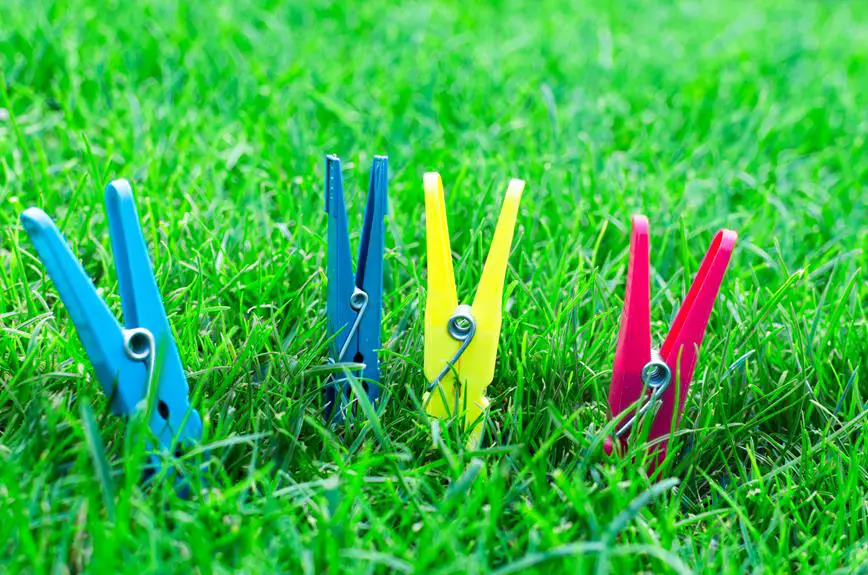Do you ever feel the frustration of discovering that your favorite white shirt has turned a pale shade of pink?
When it comes to laundry, the decision of whether to dry colors and whites together can be a tricky one. Understanding the properties of different fabric types and the potential risks of mixing colors and whites is essential for mastering the art of laundry.
This brief guide will provide you with the knowledge and tips needed to make an informed decision on whether to dry your colors and whites together, offering insights into sorting, potential risks, and safe drying practices.
Key Takeaways
- Different fabrics require different drying temperatures and techniques.
- Group similar colors together to prevent color bleeding and fading.
- Wash dark colors, bright colors, and whites separately to prevent color transfer.
- Use low heat setting to prevent color bleeding and fabric damage.
Understanding Fabric Types
You should sort your laundry by fabric type to ensure that colors and whites can be dried together safely. Understanding fabric types is crucial for effective laundry care. Different fabrics require different drying temperatures and techniques to maintain their quality. Cotton, for example, can withstand higher heat settings, while delicate fabrics like silk or wool need lower temperatures to prevent damage.
Sorting your laundry into categories such as cotton, synthetics, delicates, and whites helps you avoid potential shrinking, color bleeding, or damage during the drying process.
To identify fabric types, check the clothing label for care instructions. These labels provide valuable information on the materials used and recommended care methods. Fabrics like denim, terry cloth, and linen benefit from a higher heat setting, while spandex, silk, and wool require gentle, low-heat drying.
Sorting Laundry by Color
When sorting laundry by color, you can benefit from grouping similar colors together to prevent color bleeding and fading.
This practice also helps ensure that each fabric type receives the appropriate care during washing and drying.
Color Grouping Benefits
Sorting laundry by color offers several benefits, including preserving the vibrancy and integrity of each garment. By separating your laundry into color groups, you can prevent color bleeding, maintain the brightness of your clothes, and extend the life of your garments. Here is a table that illustrates the benefits of sorting laundry by color:
| Color Group | Benefits |
|---|---|
| Whites | Prevents discoloration and maintains brightness |
| Lights | Avoids color transfer and fading |
| Darks | Prevents light-colored items from staining |
| Reds | Reduces the risk of color bleeding |
| Delicates | Minimizes damage and preserves fabric integrity |
Sorting your laundry by color not only enhances color maintenance but also contributes to fabric preservation, ensuring your clothes look their best for longer.
Preventing Color Bleeding
To prevent color bleeding when drying colors and whites together, prioritize sorting laundry by color to maintain garment integrity and vibrancy. Preventing bleeding is essential to preserving the quality of your clothes.
Start by separating dark colors, bright colors, and whites into distinct loads. This will minimize the risk of color transfer during the washing and drying processes.
Additionally, always wash new, brightly colored garments separately as they're more likely to bleed. When in doubt, use color-catching sheets or detergents that trap loose dyes and prevent them from re-depositing onto other fabrics.
Sorting for Fabric Care
To ensure proper fabric care and prevent color bleeding, it's important to continue the process of sorting your laundry by color. Sorting laundry by color is crucial for maintaining the quality and appearance of your clothes. When sorting, separate whites, lights, and darks to prevent color transfer during the washing process. Additionally, consider sorting by fabric type and level of soiling. Following these steps will help prevent colors from bleeding onto lighter fabrics and preserve the vibrancy of your clothes.
Sorting your laundry for fabric care not only prevents color mishaps but also ensures that each load receives the appropriate washing conditions. By taking the time to sort your laundry, you can prolong the lifespan of your clothes and maintain their original appearance.
Potential Risks of Mixing Colors and Whites
When you mix colors and whites in the laundry, there's a risk of color bleeding, which can result in the transfer of dyes from one garment to another.
Additionally, certain fabrics may be more prone to damage when washed with items of a different color.
To ensure the safety and quality of your clothing, it's important to take the time to sort your laundry properly before washing.
Color Bleeding Risk
You risk color bleeding when drying colors and whites together. Color bleeding can occur due to the transfer of dyes from colorfast clothing to white fabrics. This can result in unwanted discoloration and stains on your white garments.
To minimize the risk of color bleeding, consider the following:
- Separate by Color: Sort your laundry by color to prevent dye transfer. Wash and dry whites separately from colored garments to avoid potential color bleeding.
- Test for Colorfastness: Before drying any new or vibrant colored clothing with whites, perform a colorfastness test. Dampen a small, inconspicuous area of the colored fabric and press it onto a white cloth. If the dye transfers, avoid drying the garment with whites.
- Use Color Catcher Sheets: Consider using color catcher sheets in the dryer to absorb any loose dyes and prevent them from staining white clothes.
Fabric Damage Potential
Fabric damage can result from mixing colors and whites in the dryer, potentially causing fading, discoloration, or fabric weakening. To understand the potential risks, consider the table below:
| Potential Risks | Description |
|---|---|
| Fading | Mixing colors and whites may lead to color transfer, resulting in faded fabrics. |
| Discoloration | Dyes from colored fabrics can bleed onto white fabrics, causing discoloration. |
| Fabric Weakening | Different fabrics have varying heat tolerance, potentially weakening them when mixed together in the dryer. |
To preserve fabric and color integrity, it's crucial to separate colors and whites when drying. Taking this extra step can help maintain the vibrancy of colored fabrics and the brightness of whites, prolonging the life of your garments.
Sorting for Safety
To prevent potential fabric damage, it's important to sort colors and whites separately before drying them. Safety precautions and color preservation are key factors in ensuring the longevity of your clothing. Here are some potential risks of mixing colors and whites:
- Color Bleeding: When mixed, vibrant colors can bleed onto lighter fabrics, causing staining and discoloration.
- Fabric Damage: Whites may become dull or discolored when washed with colored clothing, leading to a lack of brightness and a worn-out appearance.
- Color Transfer: Dark colors may transfer onto lighter fabrics during the drying process, resulting in an undesirable mix of colors and potential damage to the white garments.
Tips for Safe Drying
When drying colors and whites together, always use a low heat setting to prevent any potential color bleeding or fabric damage. Here are some additional tips to ensure safe drying and proper fabric care:
| Tip | Description |
|---|---|
| Separate delicate fabrics | Separate delicate fabrics such as silk or lace from heavier fabrics to prevent damage. |
| Use dryer balls or clean tennis | Use dryer balls or clean tennis balls to help fluff and separate clothes for more even drying. |
| Remove clothes promptly | Promptly remove clothes from the dryer to prevent wrinkles and reduce the need for ironing. |
| Check garment care labels | Always check garment care labels for specific drying instructions and follow them accordingly. |
Using Color-Catching Products
Consider using color-catching products when drying colors and whites together to prevent potential color bleeding and maintain the vibrancy of your garments. These products are designed to trap loose dyes during the wash and rinse cycles, preventing them from redepositing onto other clothes.
Here are some key points to consider when using color-catching products:
- Color catching effectiveness: Look for products that have been proven to effectively trap and hold onto loose dyes. Read reviews and product descriptions to ensure that the color-catching product you choose will effectively prevent color bleeding.
- Color separating techniques: While color-catching products can help prevent color bleeding, it's still important to practice good color separating techniques. Sort your laundry by color and weight, and consider using color-catching products as an additional safeguard.
- Product compatibility: Some color-catching products may not be suitable for use with certain fabrics or laundry detergents. Always check the product label for compatibility with your specific laundry needs.
Benefits of Drying Separately
Although it may seem more convenient to dry colors and whites together, there are distinct benefits to drying them separately. By separating your laundry, you can prevent fading and preserve the vibrancy of your clothes. When colors and whites are dried together, the colors may bleed onto the whites, causing them to appear dull and faded. Separating your laundry ensures that each item is treated with the care it needs, maintaining its original color and vibrancy.
| Benefits of Drying Separately |
|---|
| Prevents Fading |
| Preserves Vibrancy |
Separating your laundry also allows you to use different drying settings for each load, catering to the specific needs of colors and whites. Whites may benefit from a higher heat setting to remove stains and bacteria effectively, while colors may require a lower heat setting to prevent color fading. By drying separately, you can give each load the attention it deserves, ultimately extending the lifespan of your clothing and keeping them looking fresh and vibrant for longer.
Conclusion and Final Recommendations
To ensure the longevity and vibrancy of your clothes, it's essential to separate colors and whites when drying. Here are some final recommendations for maintaining the quality of your laundry.
- Sort your laundry carefully: Before drying, make sure to sort your laundry into separate loads of whites, lights, and darks. This simple step can prevent color bleeding and ensure that each type of fabric receives the appropriate drying temperature and time.
- Use the right detergent: Select a high-quality detergent specifically formulated for either whites or colors. This can help maintain the brightness of your whites and the richness of your colored garments, contributing to overall laundry efficiency.
- Regularly clean your dryer: Clean the lint trap and dryer vent regularly to prevent lint buildup, which can lead to decreased drying efficiency and potential fire hazards. Additionally, consider using dryer balls or clean tennis balls to help fluff and separate the laundry, reducing drying time and energy usage.
Frequently Asked Questions
Can I Use Fabric Softener When Drying Colors and Whites Together?
You can use fabric softener when drying colors and whites together. However, consider using vinegar instead to prevent shrinking and maintain color vibrancy. Vinegar helps set the dye and soften the fabric without affecting the color.
Is It Safe to Dry Clothes With Embellishments or Delicate Details With Whites?
It's not advisable to dry clothes with embellishments or delicate details with whites. Embellishment care requires special attention to avoid damage, and delicate fabric precautions should be taken to ensure the garments remain in good condition.
How Can I Prevent Colors From Bleeding Onto Whites in the Dryer?
To prevent color bleeding, separate laundry by colors and whites before drying. This helps avoid dye transfer and keeps whites looking bright. By separating your laundry, you can maintain the quality of your garments.
Are There Any Specific Dryer Settings I Should Use When Drying Colors and Whites Together?
When drying colors and whites together, ensure colorfastness testing before use. Use low heat to prevent color bleeding and shrinking. Opt for a short drying cycle to avoid over-drying. Consider adding a color catcher sheet for added protection.
Can I Use Bleach When Drying Colors and Whites Together?
You shouldn't use bleach when drying colors and whites together. Instead, consider using bleach alternatives and color-safe detergents when washing. Additionally, always separate colors from whites to ensure proper fabric care during the drying process.
- Can You Get Organza Wet? - April 23, 2024
- Why Is Organza so Popular? - April 23, 2024
- What Do You Wear With Organza? - April 23, 2024








